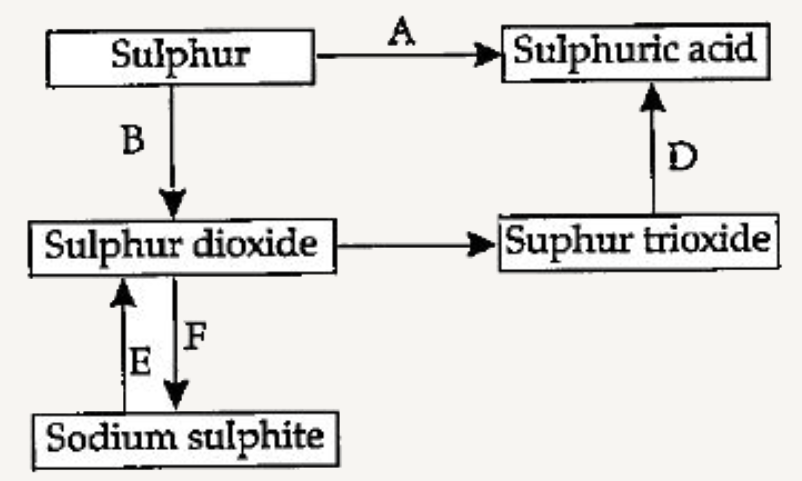Name the processes you would use to separate a mixture of calcium carbonate and common salt.
To separate a mixture of calcium carbonate and common salt (sodium chloride), we can follow these steps:
1. Dissolve the Mixture in Water:
- Take the mixture of calcium carbonate (CaCO₃) and common salt (NaCl) and add it to water.
- Calcium carbonate is insoluble in water, while common salt is soluble.
2. Stir the Mixture:
- Stir the mixture well to ensure that the common salt dissolves completely in the water, while the calcium carbonate remains undissolved.
3. Filter the Mixture:
- Use a filter paper and funnel to filter the mixture.
- The undissolved calcium carbonate will remain on the filter paper, while the dissolved common salt will pass through and collect in the filtrate.
4. Collect the Filtrate:
- The liquid that passes through the filter paper (the filtrate) contains the dissolved common salt (NaCl) in water.
5. Evaporate the Water:
- To obtain the common salt from the filtrate, heat the filtrate to evaporate the water.
- As the water evaporates, the common salt will crystallize and can be collected.
6. Collect Calcium Carbonate:
- The calcium carbonate that was left on the filter paper can be collected as it is already separated from the common salt.
Summary of Processes Used:
- Dissolution: To dissolve the soluble component (common salt).
- Filtration: To separate the insoluble component (calcium carbonate) from the solution.
- Evaporation: To obtain the dissolved common salt from the filtrate.
- Take the mixture of calcium carbonate (CaCO₃) and common salt (NaCl) and add it to water.
- Calcium carbonate is insoluble in water, while common salt is soluble.
- Stir the mixture well to ensure that the common salt dissolves completely in the water, while the calcium carbonate remains undissolved.
- Use a filter paper and funnel to filter the mixture.
- The undissolved calcium carbonate will remain on the filter paper, while the dissolved common salt will pass through and collect in the filtrate.
- The liquid that passes through the filter paper (the filtrate) contains the dissolved common salt (NaCl) in water.
- To obtain the common salt from the filtrate, heat the filtrate to evaporate the water.
- As the water evaporates, the common salt will crystallize and can be collected.
- The calcium carbonate that was left on the filter paper can be collected as it is already separated from the common salt.
- Dissolution: To dissolve the soluble component (common salt).
- Filtration: To separate the insoluble component (calcium carbonate) from the solution.
- Evaporation: To obtain the dissolved common salt from the filtrate.
Topper's Solved these Questions
- ELEMENTS , COMPOUNDS AND MIXTURES BOOK - ICSECHAPTER - ELEMENTS , COMPOUNDS AND MIXTURES EXERCISE - Exercise (Tick the most appropriate answer)
8 Videos
- ELEMENTS , COMPOUNDS AND MIXTURES BOOK - ICSECHAPTER - ELEMENTS , COMPOUNDS AND MIXTURES EXERCISE - Exercise (Fill in the blanks)
7 Videos
- ELEMENTS , COMPOUNDS AND MIXTURES BOOK - ICSECHAPTER - ELEMENTS , COMPOUNDS AND MIXTURES EXERCISE - Think and answer
3 Videos
- CHEMICAL REACTIONS BOOK - ICSECHAPTER - CHEMICAL REACTIONS EXERCISE - Think and answer
5 Videos
- ELEMENTS, COMPOUNDS & MIXTURESBOOK - ICSECHAPTER - ELEMENTS, COMPOUNDS & MIXTURESEXERCISE - OBJECTIVE TYPE QUESTIONS (Elements, Compounds & Mixtures)
17 Videos
Similar Questions
Write two uses of calcium carbonate.
View SolutionWrite two uses of calcium carbonate.
View SolutionName the process used to separate a mixture of two miscible liquids.
View SolutionDescribe the process of sublimation used to separate a mixture.
View Solution
Name the process used in A.
View SolutionName the process you will use to separate ammonium chloride and sodium chloride.
View SolutionName the process by which sand is separated from its mixture in water.
View SolutionTo separate a mixture of monosacharides, you would use
View SolutionThe process of sublimation is used to separate iodine from a mixture of iodine and sand. Why?
View SolutionName the products obtained by:
heating mixture of calcium formate and calcium acetate.
View Solution
